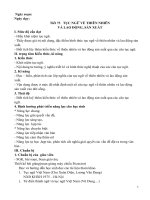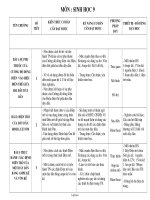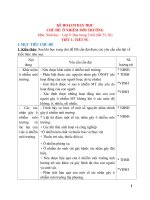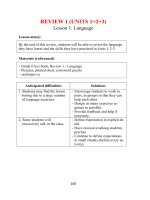Giáo án (kế hoạch bài dạy) tiếng anh 8 sách global success (kì 2) (đủ 6 bài)
Bạn đang xem bản rút gọn của tài liệu. Xem và tải ngay bản đầy đủ của tài liệu tại đây (3.99 MB, 429 trang )
UNIT 6: LIFESTYLES
Lesson 1: Getting started – Lifestyle differences
I. OBJECTIVES
By the end of this lesson, Ss will be able to:
1. Knowledge
- Gain an overview about the topic Lifestyle
- Gain vocabulary to talk about Lifestyle
2. Competences
- Develop communication skills and creativity
- Be collaborative and supportive in pair work and teamwork
- Actively join in class activities
3. Personal qualities
- Love talking about different lifestyles
II. MATERIALS
- Grade 8 textbook, Unit 6, Getting started
- Computer connected to the Internet
- Projector / TV
- hoclieu.vn
Language analysis
Form
Pronunciati
on
Meaning
say hello to somebody
Vietnamese
equivalent
1. greet (v)
/ɡriːt/
2. greeting
(n)
/ˈɡriːtɪŋ/
something that you say or lời chào
do to greet somebody
3. serve (v)
/sɜːv/
to give somebody food or phục vụ
drink, for example at a
1
chào, chào hỏi
restaurant or during a
meal
4. common
practice (n)
5. in the
habit of
/ˈkɒmən
ˈpræktɪs/
something that is done a
lot and is considered
normal
/ɪn ðə ˈhæbɪt do something regularly
or often
əv/
thơng lệ
có thói quen
làm gì
Assumption
Anticipated difficulties
Ss may lack experience
of group / teamwork.
Solutions
- Encourage Ss to work in groups
so that they can help one another.
- Give short, clear instructions,
and help if necessary.
III. PROCEDURES
1. WARM-UP (6 mins)
a. Objectives:
- To set the context for the introductory dialogue;
- To introduce the topic of the unit.
b. Content:
- Asking questions to lead in the lesson.
c. Expected outcomes:
- Students know the topic of the unit and be ready for the conversation.
d. Organisation
2
TEACHER’S AND STUDENTS’
ACTIVITIES
CONTENTS
Asking questions:
Questions and suggested answers:
- T asks Ss some questions.
- In Viet Nam, how do two men
greet each other when they meet?
- Ss answer the question individually.
- Teacher shows students a video of different
ways of greetings and asks students to guess
what the video is about.
- T sets the context for the listening and
reading text: Write the title on the board
Lifestyle – Lifestyle differences
-> They shake hands or say hello.
- Do people in Thailand shake
hands when meeting?
-> No. They greet each other with a
“Wai” and say “Sawadee”.
e. Assessment
- Teacher calls 3-5 students to answer.
2. ACTIVITY 1: PRESENTATION (10 mins)
a. Objectives:
- To prepare vocabulary for students to understand the conversation.
b. Content:
- Vocabulary pre-teaching.
c. Expected outcomes:
- Students know how to use the target vocabulary.
d. Organisation
TEACHER’S AND STUDENTS’
ACTIVITIES
CONTENTS
Vocabulary pre-teaching
New words:
- Teacher explains the meaning of the new
vocabulary by pictures.
1. greet (v)
3
2. greeting (n)
- Teacher reveals that the words according to 3. serve (v)
the pictures will appear in the reading text
4. common practice (n)
and asks students to open their textbook to
5. in the habit of
find these words.
- Teacher introduces the vocabulary.
- Teacher checks students’ understanding
with the “Rub out and remember” technique.
e. Assessment
- Teacher checks students’ pronunciation and gives feedback.
- Rub and check the vocabulary.
3. ACTIVITY 2: PRACTICE (20 mins)
a. Objectives:
- To help Ss use words and phrases related to lifestyles.
- To help Ss further understand the text.
- To introduce some vocabulary items and collocations related to lifestyles.
b. Content:
- Task 1: Listen and read.
- Task 2: Read the conversation again and complete the table.
- Task 3: Complete each sentence with a word or phrase from the box.
- Task 4: Label each picture with a word or phrase from the box.
c. Expected outcomes:
- Students understand the conversation and know the vocabulary related to
the topic.
d. Organisation
TEACHER’S AND STUDENTS’
ACTIVITIES
4
CONTENTS
Task 1: Listen and read. (7 mins)
- Ask Ss to look at the title of the
Question and suggested answer:
conversation and the pictures and guess what - What do you think Nam and Tom
the conversation between Nam and Tom
are talking about?
might be about.
-> They are talking about lifestyles
- Play the recording once or twice for Ss to
and lifestyle differences.
listen and read along silently or aloud.
- Have some pairs of Ss read the
conversation aloud.
Task 2: Read the conversation again and complete the table. (5 mins)
- Teacher asks Ss to read the dialogue in
detail to answer the questions.
Answer key:
- Ask them how to do this kind of exercise.
2. on the street
Explain the strategies, if necessary (e.g.
reading the statements in the table,
underlining the key words in the statements,
locating the key words in the text, and then
completing the table).
3. store / restaurant
1. surnames
- Tell them to underline parts of the dialogue
that help them with the answers. Set a strict
time limit to ensure Ss quickly read the text
for information.
- Tell them to compare their answers in pairs
before sharing them with the class. Ask them
to give evidence
to support their answers.
Task 3: Complete each sentence with a word or phrase from the box. (5 mins)
- Teacher tells Ss to read the conversation
again and
Answer key:
ask them to share their answers with one or
more partners. T can ask for translation of
2. greet
5
1. lifestyle
some of the words and phrase in the box to
check their understanding.
3. serve
- T asks 2 students to write their answers on
the board.
5. in the habit of
4. practice
- Check the answers as a class.
Task 4: Label each picture with a word or phrase from the box. (5 mins)
- T has Ss work individually to label the
pictures with the words and phrases in the
box. Have them compare their answers with
a partner. Then ask for Ss’ answers. Quickly
write their answers on the board without
confirming the correct answers.
Answer key:
- T has Ss listen to the recording, check their
answers, and repeat the words / phrases. Ask
Ss to look at the answers on the board and
say if they are right or wrong. Confirm the
correct answers.
5. greeting
1. street food
2. food in restaurants
3. pizza
4. online learning
- Teacher checks the answers as a class and
gives feedback.
e. Assessment
- Teacher corrects the students as a whole class.
4. ACTIVITY 3: FURTHER PRACTICE (7 mins)
a. Objectives:
- To introduce greetings around the world.
b. Content:
- Task 5: QUIZZ: Greetings around the world.
c. Expected outcomes:
- Students know about greetings around the world.
6
d. Organisation
TEACHER’S AND STUDENTS’
ACTIVITIES
CONTENTS
Task 5: QUIZZ: Greetings around the
world.
Answer key:
- Model this activity with a strong student.
2. B
- Ask Ss to work in pairs. Set a time limit (2
- 3 minutes) for Ss to finish the task. T goes
round to help weaker Ss.
- Call on some Ss to share the answers.
1. A
3. B
4. B
5. A
- Confirm the correct answers. T may need
to explain to Ss if they do not know the
answers
e. Assessment
- Teacher gives corrections and feedback to students’ conversations.
5. CONSOLIDATION (3 mins)
a. Wrap-up
- Ask one or two Ss to tell the class what they have learnt.
- Ask Ss to say aloud some words and phrases they remember from the
lesson.
b. Homework
- Name a list of 10 ways of greetings from different countries.
Board Plan
7
Date of teaching
Unit 6: Lifestyle
Lesson 1: Getting started
*Warm-up
* Vocabulary
1. greet (v)
2. greeting (n)
3. serve (v)
4. common practice (n)
5. in the habit of
Task 1: Read the conversation and complete the table.
Task 2: Complete the sentences with the words and phrases from the
box.
Task 3: Label each picture with a word or phrase from the box.
Task 4: Work in pairs. Ask and answer questions in the quiz.
*Homework
8
UNIT 6: LIFESTYLES
Lesson 2: A closer look 1
I. OBJECTIVES
By the end of this lesson, Ss will be able to:
1. Knowledge
- Vocabulary: The lexical items related to Lifestyles
- Pronunciation: Correctly pronounce words that contain the sounds:
/br/ and /pr/
2. Competences
- Develop communication skills and creativity
- Be collaborative and supportive in pair work and teamwork
- Actively join in class activities
3. Personal qualities
- Love talking about different aspects of lifestyles
II. MATERIALS
- Grade 8 textbook, Unit 6, A closer look 1
- Computer connected to the Internet
- Projector / TV
- hoclieu.vn
Language analysis
Form
1. dogsled
(n)
Pronunciati
on
/ˈdɒɡsled/
Meaning
a sledge pulled by dogs
9
Vietnamese
equivalent
xe trượt tuyết
chó kéo
2. make
craft
make things with your
hands in a skilled way
làm đồ thủ
công
/ˈtraɪbl/
connected with a tribe or
tribes
thuộc bộ tộc,
thành bộ lạc
/ˈneɪtɪv/
connected with the place
where you were born and
lived for the first years of
your life
thuộc bản xứ
/meɪk krɑːft/
3. tribal (a)
4. native (a)
Assumption
Anticipated difficulties
Ss may lack experience
of group / teamwork.
Solutions
- Encourage Ss to work in groups
so that they can help one another.
- Give short, clear instructions,
and help if necessary.
III. PROCEDURES
1. WARM-UP (5 mins)
a. Objectives:
- To create an active atmosphere in the class before the lesson.
- To lead into the new lesson.
b. Content:
- Matching game
c. Expected outcomes:
- Students get some vocabulary from the lesson and be ready for the
lesson.
10
d. Organisation:
TEACHER’S AND STUDENTS’
ACTIVITIES
CONTENTS
Matching game:
Questions:
- T gives out the handouts and divides the
class into 10 groups and explains the rules.
Match the words with the correct
pictures
- Ss match the given words to the pictures
and they have to send one to stick the
handout onto the board as quickly as
possible.
Suggested answers:
- T shows students the answer on the screen
and announces the winning group.
1. dogsled (n)
2. make crafts (v)
3. native art (n)
4. weave (v)
- T sets the context for the lesson
5. tribal dance (n)
e. Assessment:
- Teacher shows students the answer on the screen and announces the
winning group.
2. ACTIVITY 1: VOCABULARY (25 mins)
a. Objectives:
- To prepare vocabulary for students to do the tasks.
- To present some nouns that describe different aspects of lifestyles.
- To give Ss more practice on how to use words related to lifestyles in
sentences.
b. Content:
- Vocabulary pre-teaching.
- Task 1: Match the words and phrases with the pictures.
- Task 2: Complete the sentences with the words and phrases from the box.
11
- Task 3: Choose the correct answer A, B, or C to complete each sentence.
c. Expected outcomes:
- Students know how to use the target vocabulary.
d. Organisation:
TEACHER’S AND STUDENTS’
ACTIVITIES
CONTENTS
Vocabulary pre-teaching
- Teacher asks students to guess the meaning New words:
of the words that they have matched in
1. dogsled (n)
Warm-up activity.
2. make crafts (v)
- Teacher introduces the vocabulary.
3. weave (v)
- Teacher checks students’ understanding by
4. native (adj)
the follow-up tasks in the student's book.
5. tribal (adj)
Task 1: Match the words and phrases with the pictures. (7 mins)
- Have Ss work in pairs. Tell them to match
the words and phrases on the left with the
pictures on the right. Then check their
answers as a class.
- Have Ss read the words and phrases aloud.
Correct their pronunciation if necessary.
Answer key:
1. e
2. d
3. c
4. a
5. b
Task 2: Complete the sentences with the words and phrases from the box. (7
mins)
- T has Ss read the sentences and choose the
correct word given to fill each blank in the
sentences.
- T tells Ss to read the sentences carefully
and look for clues so that they can choose
12
Answer key:
1. weaving
2. tribal dances
3. native art
the correct words.
4. making crafts
- T asks Ss to check their answers with their
partners. Ask for translation of some of the
words to check their understanding.
5. dogsled
- T confirms the correct answers.
Task 3: Choose the correct answer A, B, or C to complete each sentence. (7
mins)
- Have Ss read the sentences and choose the
correct options to complete the sentences.
Answer key:
- Go around and give assistance if necessary
and check their answers.
2. B
- Confirm the correct answers as a class.
1. A
3. A
4. C
5. B
e. Assessment
- Teacher checks students’ pronunciation and gives feedback.
3. ACTIVITY 3: PRONUNCIATION (13 mins)
a. Objectives:
- To help Ss identify how to pronounce the sounds /br/ and /pr/;
- To help Ss practise pronouncing these sounds in words.
b. Content:
- Task 4: Listen and repeat the words. Pay attention to the sounds /br/
and /pr/.
- Task 5: Listen and practise the sentences. Underline the words with the
sound /br/ and circle the words with /pr/.
c. Expected outcomes:
- Students repeats the words correctly
d. Organisation:
13
TEACHER’S AND STUDENTS’
ACTIVITIES
CONTENTS
Task 4: Listen and repeat the words. Pay attention to the sounds /br/ and /pr/.
(5 mins)
- Teacher asks some Ss to read out the
words first. Then play the recording for
them to listen and repeat the words they
hear. Ask them to pay close attention to the
two sounds. Play the recording as many
times as necessary.
- Explain to Ss the difference between the
two sounds if needed:
+ /br/: Put your lips together, then open
them slowly to let the air out to make the
sound /b/. Close your tongue up and round
your lips to make the sound /r/.
+ /pr/: Press your lips together, then open
your mouth suddenly to let the air out to
make the sound /p/. Close your tongue up
and round your lips to make the sound /pr/.
The puff of air that happens with the /r/
sound is bigger for the /pr/ cluster than the
puff of air for the /br/ cluster.
* T can show Ss the pronunciation video of
this Unit:
Unit 6: Lifestyles - /br/ and /pr/
- Invite some Ss to say some words they
know that include the two sounds.
Task 5: Listen and practise the sentences. Underline the words with the sound
/br/ and circle the words with /pr/. (8 mins)
- Teacher aks Ss to quickly read the
Answer key:
14
sentences and underline the words having
the sounds /br/, and circle the words having
the sound /pr/. Then play the recording for
Ss to listen and check..
1. My brother says online learning
improves our IT skills.
- Invite some Ss to share their answers.
Confirm the correct ones.
3. She briefly introduced the new
programme.
- Play the recording again for Ss to repeat
the sentences.
- Have Ss practise the sentences in pairs.
Invite some pairs to read the sentences
aloud. Comment on their
2. Santa Claus brings a lot of
presents to children.
4. He spent a lot of time preparing
for his algebra test.
5. My mum prays at the temple
before breakfast on Sundays.
pronunciation of the sounds.
e. Assessment
- Teacher gives corrections and feedback to students’ pronunciation.
4. CONSOLIDATION (2 mins)
a. Wrap-up
- Ask one or two Ss to tell the class what they have learnt.
- Ask Ss to say make some sentences with words and phrases they
remember from the lesson
b. Homework
- Students’ workbook
Board Plan
15
Date of teaching
Unit 6: Lifestyles
Lesson 2: A closer look 1
*Warm-up
* Vocabulary
1. dogsled (n)
2. make crafts (v)
3. weave (v)
4. native (adj)
5. tribal (adj)
Task 1: Match the words and phrases with the pictures.
Task 2: Complete the sentences with the words and phrases from the
box.
Task 3: Choose the correct answer A, B, or C.
* Pronunciation
Task 3: Listen and repeat the words. Pay attention to the sounds /br/
and /pr/.
Task 4: Listen and practise the sentences. Underline the words with
the sound /br/ and circle the words with the sound /pr/.
*Homework
16
17
UNIT 2: LIFE IN THE COUNTRYSIDE
Lesson 3: A closer look 2
I. OBJECTIVES
By the end of this lesson, Ss will be able to:
1. Knowledge
- use the future simple and first conditional
2. Competences
- Develop communication skills and creativity
- Be collaborative and supportive in pair work and teamwork
- Actively join in class activities
3. Personal qualities
- Love talking about future possibilities and conditions
II. MATERIALS
- Grade 8 textbook, Unit 6, A closer look 2
- Computer connected to the Internet
- Projector / TV
- hoclieu.vn
Language analysis
FUTURE SIMPLE
Structure
Examples
(+) S + will + V-inf + …
I will buy a boat.
(⎯) S + won’t / will not + V-inf I won’t / will not buy a
watch.
+…
(?) Will + S + V-inf + …?
Will you buy a helicopter?
18
FIRST CONDITIONAL
Structure: If + Present
Simple,
Future Simple
Example: If she has
1,000,000 VND,
she will buy a closet.
Assumption
Anticipated difficulties
Ss may lack experience of
group / teamwork.
Solutions
- Encourage Ss to work in
groups so that they can help
one another.
- Give short, clear
instructions, and help if
necessary.
III. PROCEDURES
1. WARM-UP (5 mins)
a. Objectives:
- To introduce the term of first conditional
b. Content:
- Asking questions to lead in the lesson.
c. Expected outcomes:
- Students’ answers.
d. Organisation
19
TEACHER’S AND STUDENTS’
ACTIVITIES
CONTENTS
Asking questions:
Question:
- Teacher asks Ss “What will you buy if
you have 1,000,000 VND?”
What will you buy if you have
1.000.000 VND?
- Ss answer the question individually.
- Teacher leads in the introduction of the
target grammar point.
- Teacher sets the context for the lesson.
e. Assessment
- Teacher corrects for students (if needed)
2. ACTIVITY 1: PRESENTATION (8 mins)
a. Objectives:
- To teach Ss the forms of future simple and first conditional
b. Content:
- Teacher asks Ss to do the exercise individually and then check their
answer in pairs.
- Invite some Ss to share their answers. Confirm the correct answers.
c. Expected outcomes:
- Students know how to use the target grammar.
d. Organisation
TEACHER’S AND STUDENTS’
ACTIVITIES
20
CONTENTS









